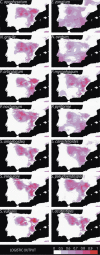Ecological niche models reveal the importance of climate variability for the biogeography of protosteloid amoebae
- PMID: 22402402
- PMCID: PMC3400416
- DOI: 10.1038/ismej.2012.12
Ecological niche models reveal the importance of climate variability for the biogeography of protosteloid amoebae
Abstract
Habitat availability and environmental preferences of species are among the most important factors in determining the success of dispersal processes and therefore in shaping the distribution of protists. We explored the differences in fundamental niches and potential distributions of an ecological guild of slime moulds-protosteloid amoebae-in the Iberian Peninsula. A large set of samples collected in a north-east to south-west transect of approximately 1000 km along the peninsula was used to test the hypothesis that, together with the existence of suitable microhabitats, climate conditions may determine the probability of survival of species. Although protosteloid amoebae share similar morphologies and life history strategies, canonical correspondence analyses showed that they have varied ecological optima, and that climate conditions have an important effect in niche differentiation. Maxent environmental niche models provided consistent predictions of the probability of presence of the species based on climate data, and they were used to generate maps of potential distribution in an 'everything is everywhere' scenario. The most important climatic factors were, in both analyses, variables that measure changes in conditions throughout the year, confirming that the alternation of fruiting bodies, cysts and amoeboid stages in the life cycles of protosteloid amoebae constitutes an advantage for surviving in a changing environment. Microhabitat affinity seems to be influenced by climatic conditions, which suggests that the micro-environment may vary at a local scale and change together with the external climate at a larger scale.
Figures



Similar articles
-
Ecological distribution of protosteloid amoebae in New Zealand.PeerJ. 2014 Mar 11;2:e296. doi: 10.7717/peerj.296. eCollection 2014. PeerJ. 2014. PMID: 24688872 Free PMC article.
-
Using environmental niche models to test the 'everything is everywhere' hypothesis for Badhamia.ISME J. 2014 Apr;8(4):737-45. doi: 10.1038/ismej.2013.183. Epub 2013 Oct 17. ISME J. 2014. PMID: 24132078 Free PMC article.
-
Microhabitat and climatic preferences of protosteloid amoebae in a region with a Mediterranean climate.Microb Ecol. 2011 Aug;62(2):361-73. doi: 10.1007/s00248-011-9843-6. Epub 2011 Mar 22. Microb Ecol. 2011. PMID: 21424821
-
Environmental niche divergence among three dune shrub sister species with parapatric distributions.Ann Bot. 2017 May 1;119(7):1157-1167. doi: 10.1093/aob/mcx004. Ann Bot. 2017. PMID: 28334085 Free PMC article.
-
Habitat availability and gene flow influence diverging local population trajectories under scenarios of climate change: a place-based approach.Glob Chang Biol. 2016 Apr;22(4):1572-84. doi: 10.1111/gcb.13189. Epub 2016 Jan 28. Glob Chang Biol. 2016. PMID: 26667878
Cited by
-
Indication of spatially random occurrence of Chlamydia-like organisms in Bufo bufo tadpoles from ponds located in the Geneva metropolitan area.New Microbes New Infect. 2018 Nov 27;27:54-63. doi: 10.1016/j.nmni.2018.11.006. eCollection 2019 Jan. New Microbes New Infect. 2018. PMID: 30622711 Free PMC article.
-
Genetic and ecological niche modeling of Calydorea crocoides (Iridaceae): an endemic species of Subtropical Highland Grasslands.Genet Mol Biol. 2018;41(1 suppl 1):327-340. doi: 10.1590/1678-4685-GMB-2017-0078. Genet Mol Biol. 2018. PMID: 29668016 Free PMC article.
-
Taxonomic and Functional Diversity of Heterotrophic Protists (Cercozoa and Endomyxa) from Biological Soil Crusts.Microorganisms. 2021 Jan 20;9(2):205. doi: 10.3390/microorganisms9020205. Microorganisms. 2021. PMID: 33498223 Free PMC article.
-
Spatiotemporal Variations of Plague Risk in the Tibetan Plateau from 1954-2016.Biology (Basel). 2022 Feb 13;11(2):304. doi: 10.3390/biology11020304. Biology (Basel). 2022. PMID: 35205170 Free PMC article.
-
Aquatic urban ecology at the scale of a capital: community structure and interactions in street gutters.ISME J. 2018 Jan;12(1):253-266. doi: 10.1038/ismej.2017.166. Epub 2017 Oct 13. ISME J. 2018. PMID: 29027996 Free PMC article.
References
-
- Agencia Estatal de Meteorología . Iberian Climate Atlas. Ministerio de Medio Ambiente y de Medio Rural y Marino: Madrid; 2011.
-
- Aguilar M, Lado C, Spiegel FW. Protostelids from deciduous forests: first data from southwestern Europe. Mycol Res. 2007;111:863–872. - PubMed
-
- Aguilar M, Spiegel FW, Lado C. Microhabitat and climatic preferences of protosteloid amoebae in a region with a mediterranean climate. Microb Ecol. 2011;62:361–373. - PubMed
-
- Amato A, Kooistra WHCF, Levialdi Ghiron JH, Mann DG, Pröschold T, Montresor M. Reproductive isolation among sympatric cryptic species in marine diatoms. Protist. 2007;158:193–207. - PubMed
-
- Anderson RP, Martínez-Meyer E. Modeling species' geographic distributions for preliminary conservation assessments: an implementation with the spiny pocket mice (Heteromys) of Ecuador. Biol Conser. 2004;116:167–179.

